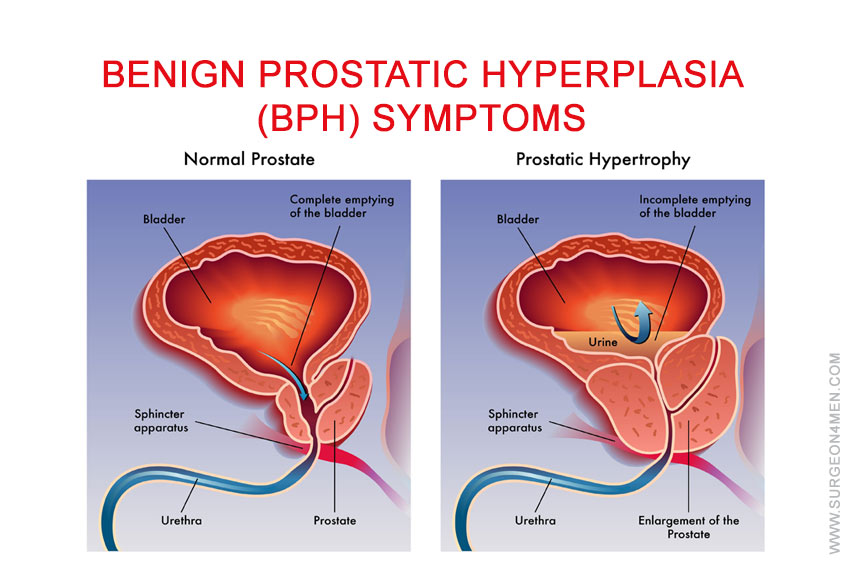Benign Prostatic Hyperplasia (BPH) Symptoms
It may seem surprising but most men who are living with benign prostatic hyperplasia (BPH) are usually symptomless. In this regard, the degree of enlargement of prostate gland does not signify the severity or intensity of the symptoms as men with mild hyperplasia may often present with severe symptoms.
Pathophysiology of Benign Prostate Hyperplasia
The prostate gland lies just beneath the urinary bladder. In addition, the substance of the prostate gland embeds the urethra (a tube that is responsible for transferring the urine from the urinary bladder to the exterior). The urinary symptoms appear, when the enlarged prostate gland compresses over the urethra; thereby occluding the tract to restrict proper urinary outflow.
The glandular part of prostate grows throughout the life in majority of the males. However, very few males experience excessive glandular growth that interferes with the urinary flow or cause absolute cessation of urinary flow. The precise mechanism is still obscure but it is postulated that the symptoms are mainly due to imbalances in the metabolism of male sex hormones (which is partly physiological with advancing age).
Classic Symptoms of Benign Prostatic Hyperplasia
The spectrum of symptoms of BPH may either be related to inadequate bladder storage or inefficient bladder emptying.
Incomplete Bladder Emptying:
Those related to incomplete bladder emptying are:
- Inability to start a regular stream of urine (also known as hesitancy).
- Inability to sustain an uninterrupted stream (or poor flow)
- Trickling of urine after urination
- Feeling of incomplete evacuation of the urinary bladder
- A persistent urge to urinate even after urinating
- Painful urination also called as dysuria
- Forceful expulsion of the urine also called as straining
Inadequate Bladder Storage:
Those symptoms related to inadequate bladder storage are:
- Increased drive to urinate at night also called as nocturia
- Increased frequency of urination
- Insidious and uncontrollable drive to urinate
Less common symptoms of benign prostatic hyperplasia include presence of blood in the urine and absolute cessation of urination.
Risk factors of Benign Prostate Hyperplasia
Following risk factors are strongly associated with BPH:
- Family History:An individual is more likely to develop symptoms of prostatic enlargement if blood relatives such as father or brother have experienced the symptomatic BPH.
- Ethnicity: Asians and black individuals are less likely to develop BPH as compared to the whites. White males experience symptoms in later decades of life.
- Coexisting Diabetes and/or Heart Disease:Previous studies have shown strong association of diabetes, heart disease and prolong beta blocker use with increased risk of benign prostatic hyperplasia.
- Sedentary Lifestyle: Obese men are more likely to develop BPH as compared to males who are physically active and exercise on regular basis.
What to Do If You are Experiencing These Symptoms?
The symptoms mentioned above are not exclusive to benign prostatic hyperplasia and can be experienced in other ailments as well. If the onset of symptoms is insidious or there is an evidence of one type of symptoms more than the other type, BPH should not be the provisional diagnosis. Other conditions mimicking the BPH are:
- Infection and inflammation of the prostate called as prostatitis
- Urinary tract infection
- Cancer of the prostate gland
- Poorly managed Diabetes
- Congestive cardiac failure or heart failure
- Narrowed urethra (also referred to as urethral stricture)
- Stones in the urinary bladder
- Stones in the kidney
- Scarring at the neck of the bladder due to previous surgery
- Cancer of the bladder
- Neurological diseases (especially in situations where involvement of lower lumbar and sacral segments of spinal cords is high)
Reference:
1. Sutcliffe, S., Grubb III, R. L., Platz, E. A., Ragard, L. R., Riley, T. L., Kazin, S. S., … & Andriole, G. L. (2012). Non‐steroidal anti‐inflammatory drug use and the risk of benign prostatic
